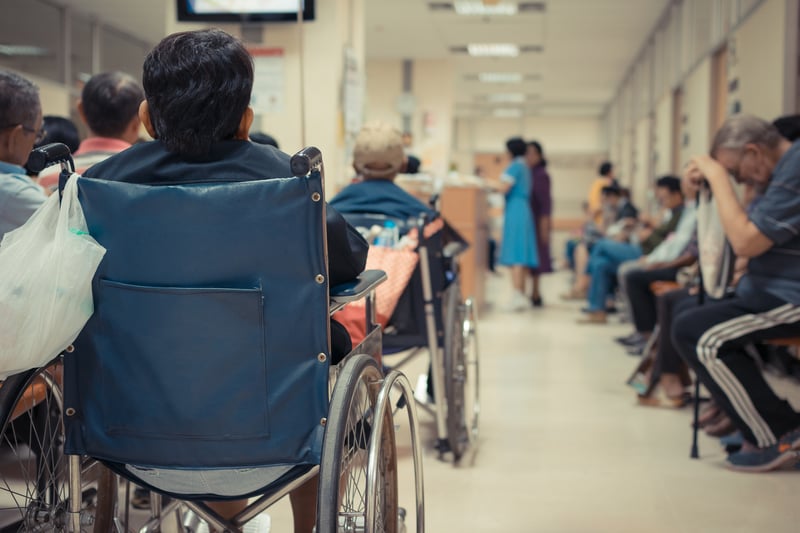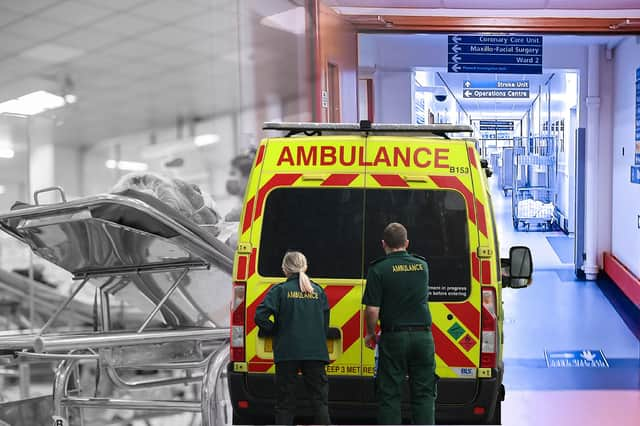Up to a third of English hospital beds were taken up by bed blockers who were fit for discharge but stuck waiting on wards last week, as the NHS continues to grapple with overflowing wards and unprecedented pressure on emergency departments.
It comes after the president of the Royal College of Emergency Medicine (RCEM) told MPs the nation’s hospital wards are “hideously” busy due to the low number of beds per head of the population. Problems with A&E care will not improve unless the government focuses on boosting bed numbers and lowering occupancy rates, he told members of the Health and Social Care Committee.
Earlier this month NationalWorld revealed how up to 60% of patients admitted as an emergency through A&E are facing 12-hour trolley waits for a bed to become available in some parts of the country, while more than 19 out of 20 hospital trusts are currently breaching ‘safe’ levels of bed occupancy.
Now analysis of weekly winter pressure data from NHS England reveals how in the week ending 22 January an average of more than one in seven general and acute hospital beds for adults were taken up by patients whose discharge had been delayed. Delayed discharges are commonly referred to as bed blocking – where a patient does not leave hospital despite being medically fit to, most commonly because they are stuck waiting for a social care package to help them return home to be put in place, according to RCEM president Dr Adrian Boyle. Prolonged stays in hospital can be detrimental to patients, as well as having a knock on effect on new patients facing delays in being admitted.
Across the seven-day period NationalWorld looked at, an average of 22,980 beds at major hospital trusts were occupied each day by patients who no longer needed to be in hospital. Of these, an average of 13,570 patients each day were not discharged, staying in hospital until at least the next day.
Separate NHS England data shows there were an average of 94,070 beds available for use on general and acute hospital wards (including those occupied), meaning an average of 14.4% of beds, or more than one in seven, were lost to bed blocking every day.
But at the East Sussex Healthcare Trust as many as a third of beds (33.6%) were taken up by patients who did not need to be in hospital. During the same week, an average of 95.5% of beds were occupied overall at the trust, far higher than the 85% threshold generally considered a safe limit of busyness, after which patients may suffer adverse outcomes.
Across England as a whole, 95.2% of beds were occupied – but if all patients fit for discharge but who remained in hospital had been able to leave, average occupancy would have dropped to 80.8%.
Last month the RCEM estimated that between 300 and 500 patients were dying each week because of A&E delays – a figure calculated by applying the known increase in fatality rates within 30 days among patients who face long waits in emergency departments, to the number of patients who waited over 12 hours to be admitted through A&E last year.
Among those blaming pressure on the health service for the death of a loved one are the devastated family of 31-year-old Brighton woman Tamara Davis, who reportedly died after being left in a hospital corridor for 12 hours. The family yesterday (30 January) announced they are considering taking legal action against University Hospitals Sussex NHS Trust over their experience
Ms Davis went to A&E on 10 January after coughing up blood, where she was left in an emergency department cubicle and then corridor with severe diarrhoea – but overworked NHS staff failed to change her soiled bed sheets or even check on her when a heart rate machine signalled she was tachycardic, her sister Miya Davis, 24, said. Tamara was eventually admitted to intensive care and put on a ventilator, but died on 13 January due to sepsis and multiple organ failure.
Dr Boyle put the“terrible” A&E performance in December down to problems with ‘patient flow’ – getting patients smoothly through the hospital system, from arrival to admission to discharge.
“We’ve certainly had the worst December we’ve ever had,” he said. “If you look at the performance figures, on every metric what went on in December was terrible. This is a complex, multi-faceted problem.
“We’ve got serious, structural problems that impair our ability to do emergency care. We have the second lowest number of beds in the OECD [Organisation for Economic Co-operation and Development]. We run our hospitals far, far too full with far too high occupancy levels. They are hideously high.”
Yesterday the government set out a plan for emergency healthcare which Prime Minister Rishi Sunak said would deliver “the largest and fastest-ever improvement in emergency waiting times in the NHS’s history”.
Speaking on a visit to County Durham, he said: “The things we’re already doing, I think you will see, made a difference in January, I think you will see a difference in the January numbers compared to December because some of the things we did on discharge to move people out of hospitals have already started to have a bit of an impact.
“I think hopefully fingers crossed when the numbers come out for January you will see things are already starting to improve.”
NationalWorld has analysed the latest data for each hospital trust to find where in England is losing the most capacity to bed blockers who are fit for discharge. The figures exclude 13 acute wards which do not operate a general purpose, 24-hour A&E for adults, such as specialist eye and heart hospitals or women’s and children’s trusts.
Note on methodology: the proportions in this article are a best estimate arrived at by combing two sets of data - a count of delayed discharges, and a count of open general and acute beds. The former technically covers critical care as well as general and acute wards, while the latter does not include critical care. If there are critical care patients counted as bed blockers, this could therefore alter the proportion of beds lost to bed blocking. It is however unlikely and unusual that a patient would be discharged straight from critical care, according to NHS England.
Earlier this month NationalWorld revealed how up to 60% of patients admitted as an emergency through A&E are facing 12-hour trolley waits for a bed to become available in some parts of the country, while more than 19 out of 20 hospital trusts are currently breaching ‘safe’ levels of bed occupancy.

13. Royal Cornwall Hospitals NHS Trust
At the Royal Cornwall Hospitals NHS Trust 223 beds were taken up each day by patients fit for discharge. Of these, 146 were not discharged, the equivalent of 23.7% of the trust's beds.

14. Salisbury NHS Foundation Trust
At the Salisbury NHS Foundation Trust 148 beds were taken up each day by patients fit for discharge. Of these, 108 were not discharged, the equivalent of 23.7% of the trust's beds.

15. Gloucestershire Hospitals NHS Foundation Trust
At the Gloucestershire Hospitals NHS Foundation Trust 258 beds were taken up each day by patients fit for discharge. Of these, 195 were not discharged, the equivalent of 23.6% of the trust's beds.


